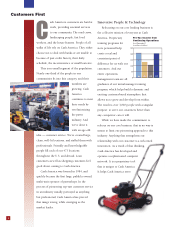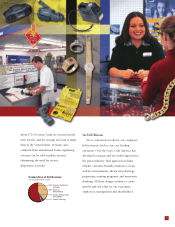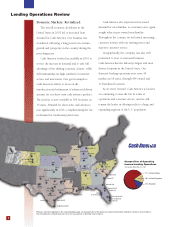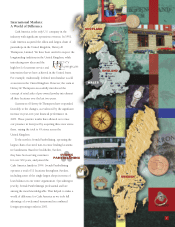Cash America 2001 Annual Report Download - page 16
Download and view the complete annual report
Please find page 16 of the 2001 Cash America annual report below. You can navigate through the pages in the report by either clicking on the pages listed below, or by using the keyword search tool below to find specific information within the annual report.
14
Management’s Discussion and Analysis of Results of Operations and Financial Condition
adjustments, a 5.7% increase in the average balance of pawn loans outstanding in
the United Kingdom resulted in an increase in finance and service charges. The
United Kingdom increase was slightly offset by the reduction in Sweden caused
by a l.6% decline in the average balance of pawn loans outstanding.
Excluding the negative effects of foreign currency translation adjustments,
the consolidated annualized loan yield was 93.4% in 2000, compared to 95.7%
in 1999. This decline resulted in a decrease in finance and service charges.
Although a slight increase in the domestic annualized loan yield to 123.3% for
2000, compared to 122.3% for 1999, contributed additional finance and service
charges, a decline in the blended yield on foreign loans caused an offsetting
decrease. The blended yield on average foreign pawn loans outstanding declined
to 49.1% in 2000 compared to 52.4% in 1999. Virtually all of the reduction in
the blended yield occurred in the United Kingdom and was caused by a combina-
tion of lower loan redemption rates and lower returns on the disposition of unre-
deemed collateral at auction.
Foreign source finance and service charges declined $1.8 million in 2000
due to negative currency translation adjustments resulting from the strengthening
of the United States dollar against both foreign currencies. The weighted average
exchange rates used for translating earnings into United States dollars for the
British pound sterling and Swedish kronor were 6.5% and 13.6% lower, respec-
tively, during 2000 compared to 1999.
Net Revenue from the Disposition of Merchandise. The combination of reduced
proceeds and higher margin caused a $.5 million, or .7%, decrease in net revenue
from the disposition of merchandise. The following table summarizes by operat-
ing segment the change in the proceeds from the disposition of merchandise and
the related net margin for 2000 compared to 1999 ($ in millions):
Increase (decrease)
Disposition % Net %
Proceeds Change Margin Change
Domestic lending $ (11.8) (5.1)% $ (0.3) (0.3)%
Foreign lending 3.1 54.4% (0.2) (25.7)%
Total $ (8.7) (3.7)% $ (0.5) (0.7)%
Proceeds from the disposition of merchandise were 3.7%, or $8.7 million,
lower in 2000 than in 1999 primarily due to lower average merchandise levels and
lower sales prices in the domestic lending operations. Same unit proceeds declined
$7.6 million, including approximately $.5 million resulting from declines in foreign
currency exchange rates compared to 1999 rates. The margin on disposition of
merchandise increased to 33.2% in 2000 from 32.2% in 1999. Excluding the effect
of the disposition of scrap jewelry, the margin on disposition of merchandise
increased to 35.3% in 2000 from 34.1% in 1999 due to a lower average cost of
merchandise disposed. The margin on disposition of scrap jewelry was 2.6% in
2000 compared to 1.8% in 1999. The merchandise turnover rate increased to 2.5
times during 2000 from 2.4 times during 1999. Since the end of the second
quarter of 1999, management has concentrated on discounting prices, lowering
the average cost of merchandise held for disposition, and reducing aggregate
merchandise levels.
Other Lending Fees and Royalties. Other lending fees and royalties increased a
combined amount of $1.1 million in 2000 as compared to 1999. Of the increase,
$1.0 million resulted from the initiation of the cash advance product that was
introduced into 330 of the domestic lending units by the end of 2000, including
187 units that offer the product on behalf of the Bank.
During 2000, $10.1 million of advances were written, including $1.4 mil-
lion extended to customers by the Bank, for an average of $187 per advance. As
of December 31, 2000, $1.6 million of gross advances were outstanding, includ-
ing $.6 million extended to customers by the Bank that is not included in the
Company’s consolidated balance sheet. An allowance for losses of $.2 million,
representing 23.1% of the Company’s gross advances outstanding of $1.0 million,
has been provided in the consolidated financial statements for 2000.
Check Cashing Royalties and Fees. Net revenue for Mr. Payroll decreased $.1
million, or 2.0%, from the prior year, while check cashing fees in the United
Kingdom remained flat at $.7 million. The 1999 restructuring of the Company’s
check cashing machine operations and deconsolidation of innoVentry resulted in
the remaining $.4 million decrease in check cashing revenue in 2000 as com-
pared to 1999.
Operations and Administration Expenses. Due in part to the 4.1%
decrease in consolidated net revenue, consolidated operations and administration
expenses as a percentage of net revenue were 76.4% in 2000 compared to 73.8%
in 1999. Combined operations and administration expenses decreased $1.1 mil-
lion, or .7%, in 2000 as compared to 1999. This decline was driven by check
cashing operations which experienced a decrease in expenses of $3.8 million as a
result of the deconsolidation of innoVentry in March 1999 and losses from fraud-
ulently cashed income tax checks included in 1999 that did not recur in 2000.
This decrease was offset by domestic lending expenses, which increased $2.5 mil-
lion primarily as a result of rollout costs and continuing expenses associated with
the introduction of small consumer cash advances into 330 lending units. Also
contributing to increases were higher personnel benefits, occupancy, and travel
expenses. Foreign lending operations contributed $.2 million of the increase.
Depreciation and Amortization. Depreciation and amortization expenses
as a percentage of net revenue were 8.4% in 2000 compared to 9.1% in 1999.
Total depreciation and amortization expenses decreased $2.2 million, or 11.9%.
The decreased expense resulted primarily from a moderation in the unit expan-
sion of lending operations and retirements of property that occurred because of
severe tornado damage to the Company’s corporate headquarters in March 2000.
Interest Expense. Net interest expense as a percentage of net revenue was
6.7% in both 2000 and 1999. The amount decreased a net $.6 million, or 4.3%,
due to the effect of a 7.2% reduction in the Company’s average debt balance that
was partially offset by higher blended borrowing costs. The average amount of
debt outstanding decreased during 2000 to $189.9 million from $204.6 million
during 1999. Factors contributing to the reduction were lower pawn loan and
merchandise balances, and the receipt of insurance proceeds in 2000 from claims
resulting from the tornado damage to the corporate headquarters. The effective
blended borrowing cost increased slightly to 6.9% in 2000 from 6.7% in 1999.
Other Items. A $9.7 million gain (before income tax expense of $3.4 million)
from the settlement of the insurance claims related to the tornado damage to
the corporate headquarters was recorded in 2000. See Note 7 of Notes to
Consolidated Financial Statements. In 1999, the Company recorded a $2.2 million
gain (before income tax expense of $.8 million) from the sale of 3 lending units to
a related party. See Note 16 of Notes to Consolidated Financial Statements.
Equity in loss of unconsolidated subsidiary was $15.6 million in 2000 com-
pared to $15.2 million in 1999. The Company recorded a pre-tax gain of $.1
million from the issuance of innoVentry’s common stock in 2000 compared to a
pre-tax gain of $5.2 million from the issuance of innoVentry’s Series A and B vot-
ing preferred stock and common stock in 1999. As of June 30, 2000, the
Company’s proportionate share of innoVentry’s losses exceeded the carrying
amount of its investment in and advances to innoVentry. Since the Company has
no obligation to provide financial support to innoVentry, as of June 30, 2000 it
suspended the recording of its equity in innoVentry’s losses as well as gains or
losses resulting from the issuance of innoVentry’s common stock.
























